INF70005 Assignment 1: Critical Evaluation of Tata Nano Project
VerifiedAdded on 2023/01/20
|11
|2810
|35
Report
AI Summary
This report offers a critical evaluation of the Tata Nano project, examining its strategic project management aspects. It begins with an introduction to strategic project management and provides background information on Tata Motors and the Nano project. The report then outlines the standard criteria for the project, highlighting areas where the Nano fell short, such as practicality, marketing, build quality, and customer service. A critical analysis is conducted, exploring factors like safety concerns, production delays, and the car's positioning in the market. Porter's five forces are applied to assess the competitive environment. The report concludes by summarizing the key reasons for the Nano's failure, emphasizing the lack of modern features, safety issues, and poor customer connection. The analysis provides insights into the strategic missteps that led to the project's ultimate demise.
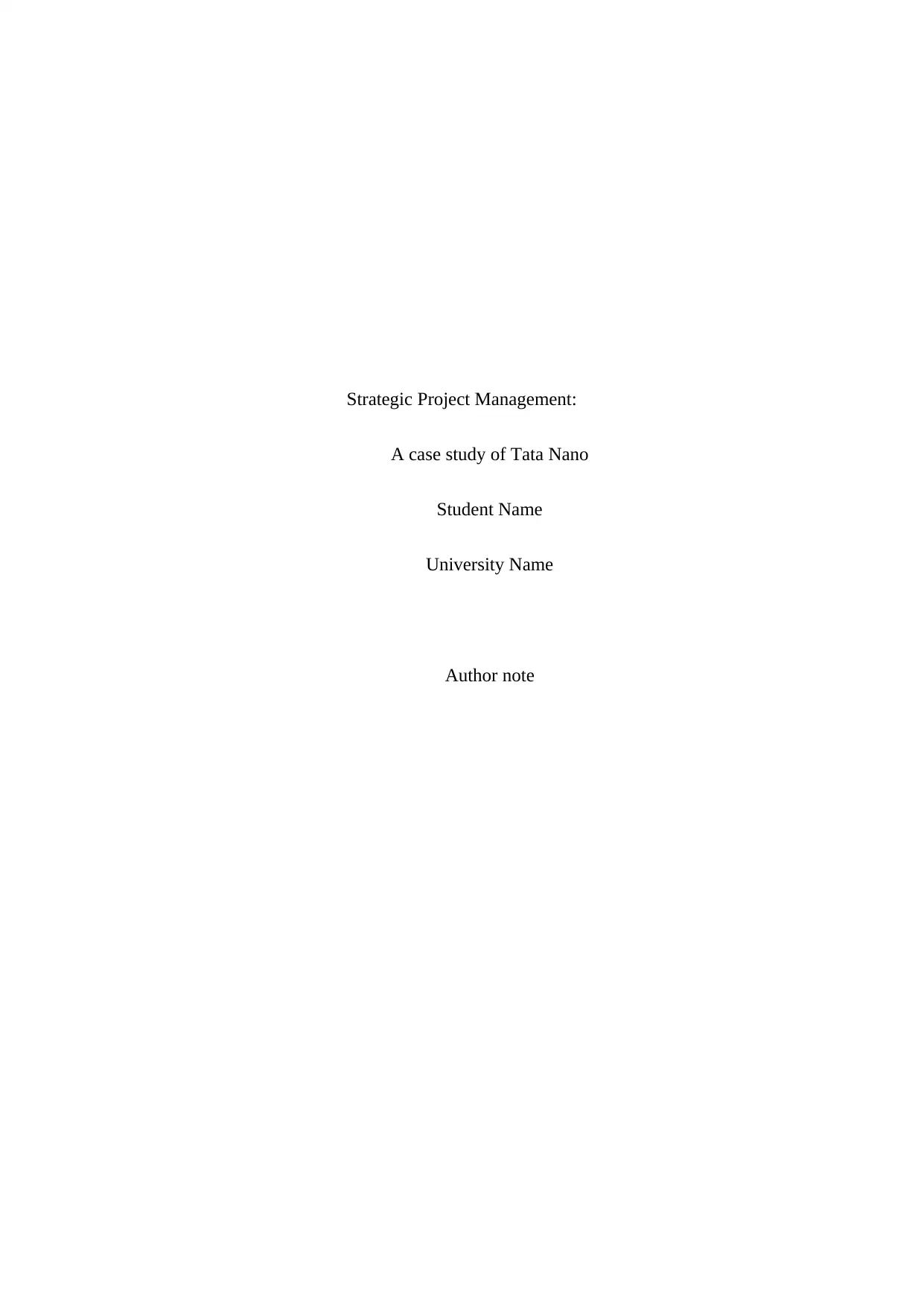
Strategic Project Management:
A case study of Tata Nano
Student Name
University Name
Author note
A case study of Tata Nano
Student Name
University Name
Author note
Paraphrase This Document
Need a fresh take? Get an instant paraphrase of this document with our AI Paraphraser
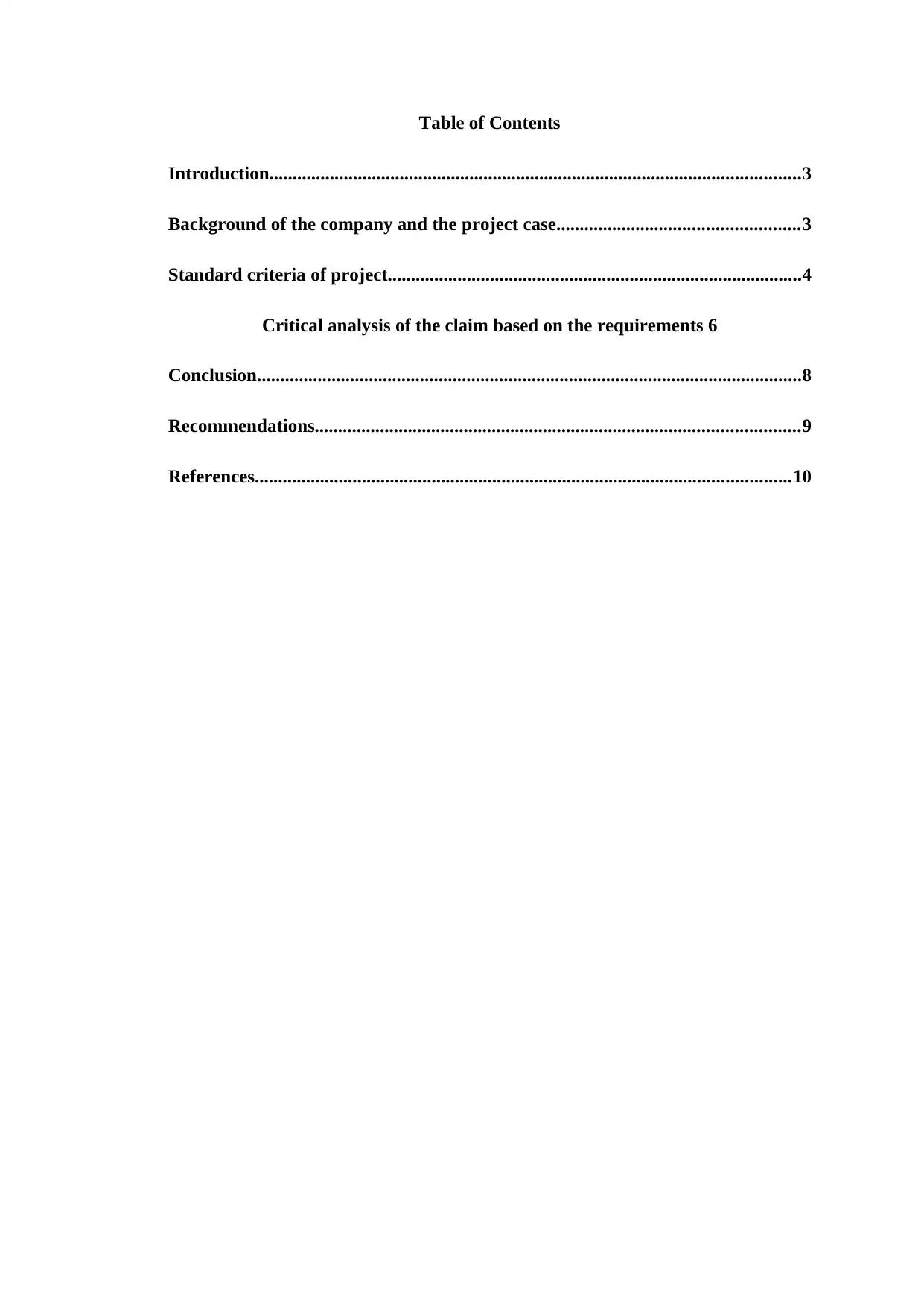
Table of Contents
Introduction..................................................................................................................3
Background of the company and the project case....................................................3
Standard criteria of project.........................................................................................4
Critical analysis of the claim based on the requirements 6
Conclusion.....................................................................................................................8
Recommendations........................................................................................................9
References...................................................................................................................10
Introduction..................................................................................................................3
Background of the company and the project case....................................................3
Standard criteria of project.........................................................................................4
Critical analysis of the claim based on the requirements 6
Conclusion.....................................................................................................................8
Recommendations........................................................................................................9
References...................................................................................................................10
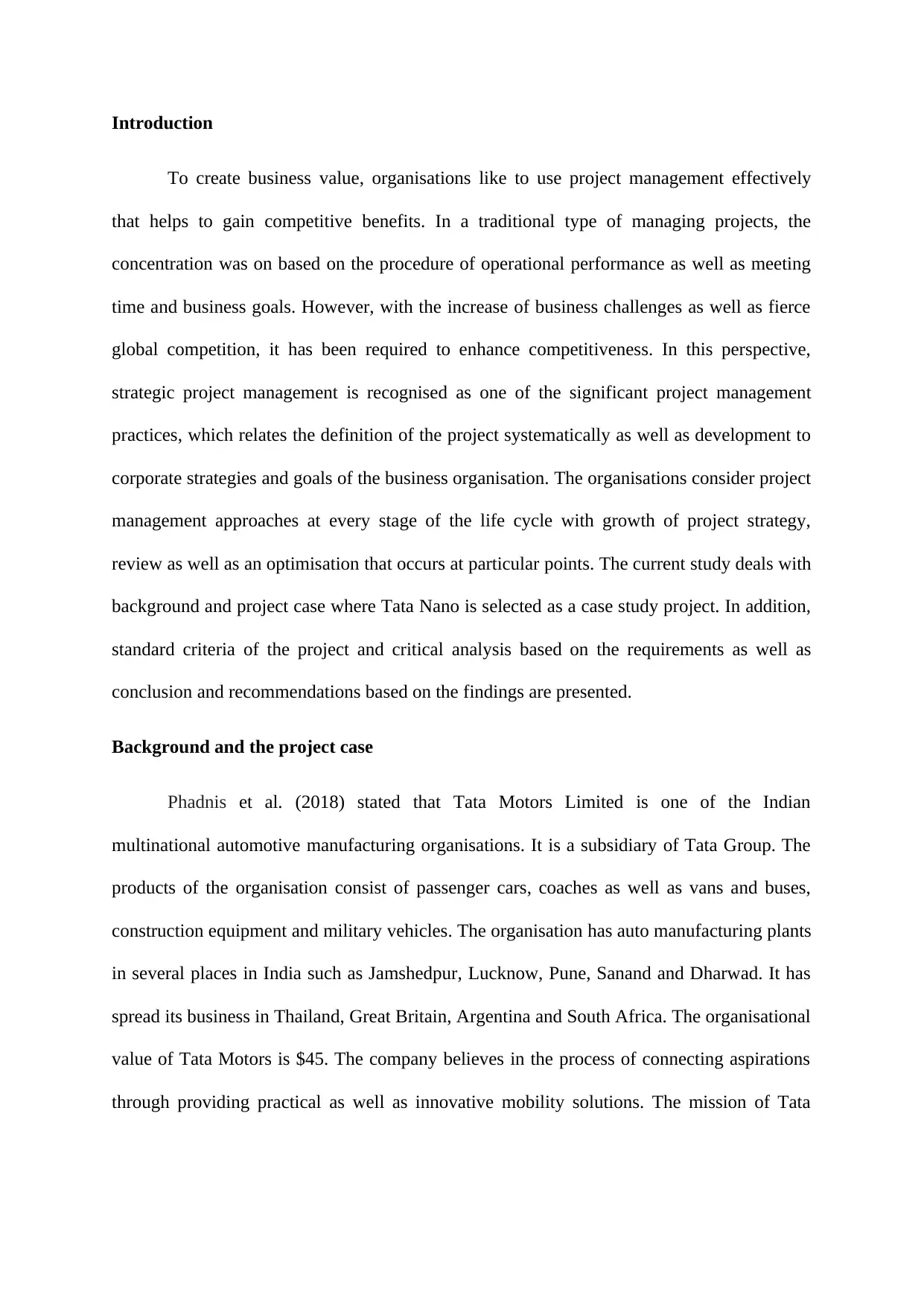
Introduction
To create business value, organisations like to use project management effectively
that helps to gain competitive benefits. In a traditional type of managing projects, the
concentration was on based on the procedure of operational performance as well as meeting
time and business goals. However, with the increase of business challenges as well as fierce
global competition, it has been required to enhance competitiveness. In this perspective,
strategic project management is recognised as one of the significant project management
practices, which relates the definition of the project systematically as well as development to
corporate strategies and goals of the business organisation. The organisations consider project
management approaches at every stage of the life cycle with growth of project strategy,
review as well as an optimisation that occurs at particular points. The current study deals with
background and project case where Tata Nano is selected as a case study project. In addition,
standard criteria of the project and critical analysis based on the requirements as well as
conclusion and recommendations based on the findings are presented.
Background and the project case
Phadnis et al. (2018) stated that Tata Motors Limited is one of the Indian
multinational automotive manufacturing organisations. It is a subsidiary of Tata Group. The
products of the organisation consist of passenger cars, coaches as well as vans and buses,
construction equipment and military vehicles. The organisation has auto manufacturing plants
in several places in India such as Jamshedpur, Lucknow, Pune, Sanand and Dharwad. It has
spread its business in Thailand, Great Britain, Argentina and South Africa. The organisational
value of Tata Motors is $45. The company believes in the process of connecting aspirations
through providing practical as well as innovative mobility solutions. The mission of Tata
To create business value, organisations like to use project management effectively
that helps to gain competitive benefits. In a traditional type of managing projects, the
concentration was on based on the procedure of operational performance as well as meeting
time and business goals. However, with the increase of business challenges as well as fierce
global competition, it has been required to enhance competitiveness. In this perspective,
strategic project management is recognised as one of the significant project management
practices, which relates the definition of the project systematically as well as development to
corporate strategies and goals of the business organisation. The organisations consider project
management approaches at every stage of the life cycle with growth of project strategy,
review as well as an optimisation that occurs at particular points. The current study deals with
background and project case where Tata Nano is selected as a case study project. In addition,
standard criteria of the project and critical analysis based on the requirements as well as
conclusion and recommendations based on the findings are presented.
Background and the project case
Phadnis et al. (2018) stated that Tata Motors Limited is one of the Indian
multinational automotive manufacturing organisations. It is a subsidiary of Tata Group. The
products of the organisation consist of passenger cars, coaches as well as vans and buses,
construction equipment and military vehicles. The organisation has auto manufacturing plants
in several places in India such as Jamshedpur, Lucknow, Pune, Sanand and Dharwad. It has
spread its business in Thailand, Great Britain, Argentina and South Africa. The organisational
value of Tata Motors is $45. The company believes in the process of connecting aspirations
through providing practical as well as innovative mobility solutions. The mission of Tata
⊘ This is a preview!⊘
Do you want full access?
Subscribe today to unlock all pages.

Trusted by 1+ million students worldwide
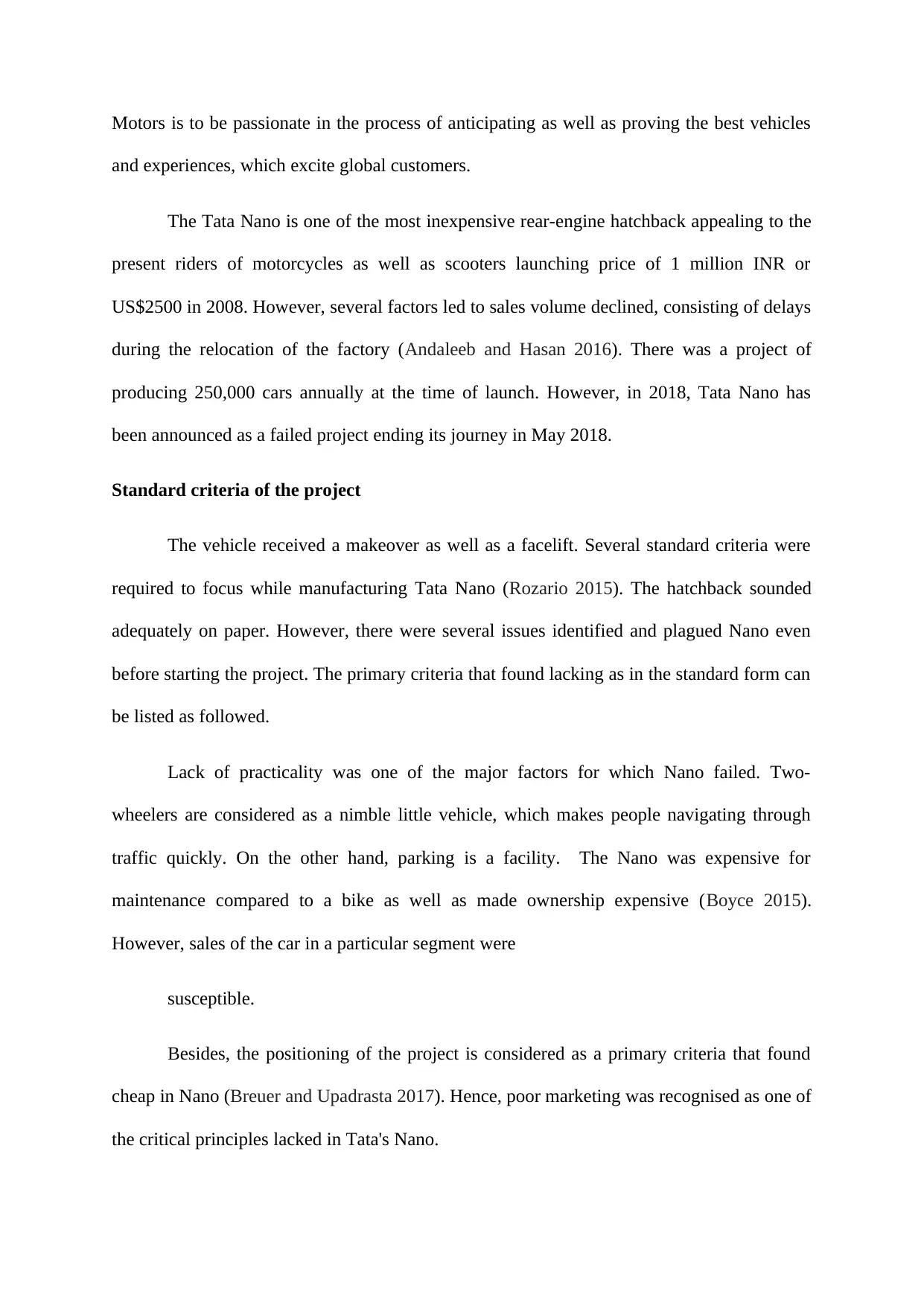
Motors is to be passionate in the process of anticipating as well as proving the best vehicles
and experiences, which excite global customers.
The Tata Nano is one of the most inexpensive rear-engine hatchback appealing to the
present riders of motorcycles as well as scooters launching price of 1 million INR or
US$2500 in 2008. However, several factors led to sales volume declined, consisting of delays
during the relocation of the factory (Andaleeb and Hasan 2016). There was a project of
producing 250,000 cars annually at the time of launch. However, in 2018, Tata Nano has
been announced as a failed project ending its journey in May 2018.
Standard criteria of the project
The vehicle received a makeover as well as a facelift. Several standard criteria were
required to focus while manufacturing Tata Nano (Rozario 2015). The hatchback sounded
adequately on paper. However, there were several issues identified and plagued Nano even
before starting the project. The primary criteria that found lacking as in the standard form can
be listed as followed.
Lack of practicality was one of the major factors for which Nano failed. Two-
wheelers are considered as a nimble little vehicle, which makes people navigating through
traffic quickly. On the other hand, parking is a facility. The Nano was expensive for
maintenance compared to a bike as well as made ownership expensive (Boyce 2015).
However, sales of the car in a particular segment were
susceptible.
Besides, the positioning of the project is considered as a primary criteria that found
cheap in Nano (Breuer and Upadrasta 2017). Hence, poor marketing was recognised as one of
the critical principles lacked in Tata's Nano.
and experiences, which excite global customers.
The Tata Nano is one of the most inexpensive rear-engine hatchback appealing to the
present riders of motorcycles as well as scooters launching price of 1 million INR or
US$2500 in 2008. However, several factors led to sales volume declined, consisting of delays
during the relocation of the factory (Andaleeb and Hasan 2016). There was a project of
producing 250,000 cars annually at the time of launch. However, in 2018, Tata Nano has
been announced as a failed project ending its journey in May 2018.
Standard criteria of the project
The vehicle received a makeover as well as a facelift. Several standard criteria were
required to focus while manufacturing Tata Nano (Rozario 2015). The hatchback sounded
adequately on paper. However, there were several issues identified and plagued Nano even
before starting the project. The primary criteria that found lacking as in the standard form can
be listed as followed.
Lack of practicality was one of the major factors for which Nano failed. Two-
wheelers are considered as a nimble little vehicle, which makes people navigating through
traffic quickly. On the other hand, parking is a facility. The Nano was expensive for
maintenance compared to a bike as well as made ownership expensive (Boyce 2015).
However, sales of the car in a particular segment were
susceptible.
Besides, the positioning of the project is considered as a primary criteria that found
cheap in Nano (Breuer and Upadrasta 2017). Hence, poor marketing was recognised as one of
the critical principles lacked in Tata's Nano.
Paraphrase This Document
Need a fresh take? Get an instant paraphrase of this document with our AI Paraphraser
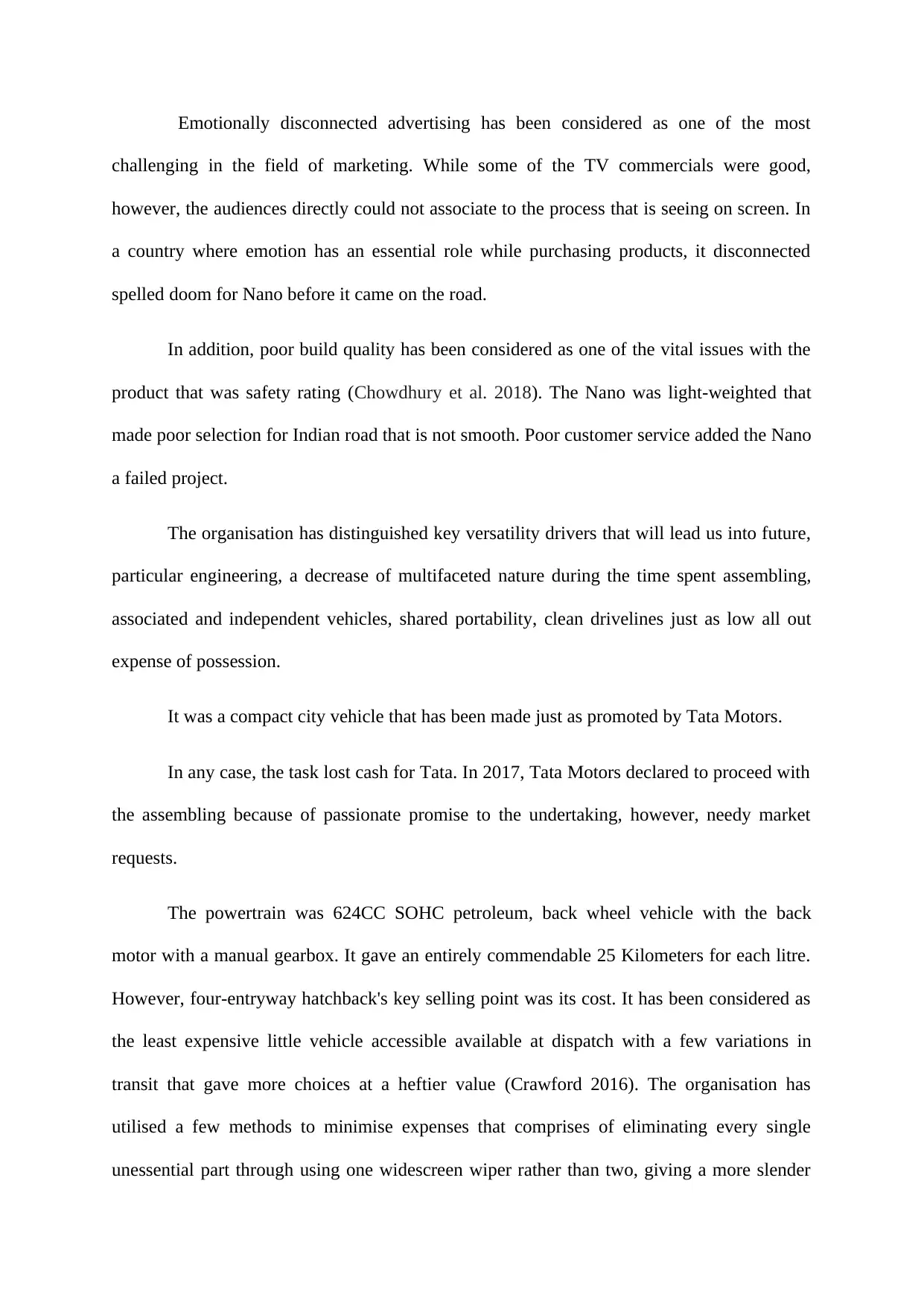
Emotionally disconnected advertising has been considered as one of the most
challenging in the field of marketing. While some of the TV commercials were good,
however, the audiences directly could not associate to the process that is seeing on screen. In
a country where emotion has an essential role while purchasing products, it disconnected
spelled doom for Nano before it came on the road.
In addition, poor build quality has been considered as one of the vital issues with the
product that was safety rating (Chowdhury et al. 2018). The Nano was light-weighted that
made poor selection for Indian road that is not smooth. Poor customer service added the Nano
a failed project.
The organisation has distinguished key versatility drivers that will lead us into future,
particular engineering, a decrease of multifaceted nature during the time spent assembling,
associated and independent vehicles, shared portability, clean drivelines just as low all out
expense of possession.
It was a compact city vehicle that has been made just as promoted by Tata Motors.
In any case, the task lost cash for Tata. In 2017, Tata Motors declared to proceed with
the assembling because of passionate promise to the undertaking, however, needy market
requests.
The powertrain was 624CC SOHC petroleum, back wheel vehicle with the back
motor with a manual gearbox. It gave an entirely commendable 25 Kilometers for each litre.
However, four-entryway hatchback's key selling point was its cost. It has been considered as
the least expensive little vehicle accessible available at dispatch with a few variations in
transit that gave more choices at a heftier value (Crawford 2016). The organisation has
utilised a few methods to minimise expenses that comprises of eliminating every single
unessential part through using one widescreen wiper rather than two, giving a more slender
challenging in the field of marketing. While some of the TV commercials were good,
however, the audiences directly could not associate to the process that is seeing on screen. In
a country where emotion has an essential role while purchasing products, it disconnected
spelled doom for Nano before it came on the road.
In addition, poor build quality has been considered as one of the vital issues with the
product that was safety rating (Chowdhury et al. 2018). The Nano was light-weighted that
made poor selection for Indian road that is not smooth. Poor customer service added the Nano
a failed project.
The organisation has distinguished key versatility drivers that will lead us into future,
particular engineering, a decrease of multifaceted nature during the time spent assembling,
associated and independent vehicles, shared portability, clean drivelines just as low all out
expense of possession.
It was a compact city vehicle that has been made just as promoted by Tata Motors.
In any case, the task lost cash for Tata. In 2017, Tata Motors declared to proceed with
the assembling because of passionate promise to the undertaking, however, needy market
requests.
The powertrain was 624CC SOHC petroleum, back wheel vehicle with the back
motor with a manual gearbox. It gave an entirely commendable 25 Kilometers for each litre.
However, four-entryway hatchback's key selling point was its cost. It has been considered as
the least expensive little vehicle accessible available at dispatch with a few variations in
transit that gave more choices at a heftier value (Crawford 2016). The organisation has
utilised a few methods to minimise expenses that comprises of eliminating every single
unessential part through using one widescreen wiper rather than two, giving a more slender
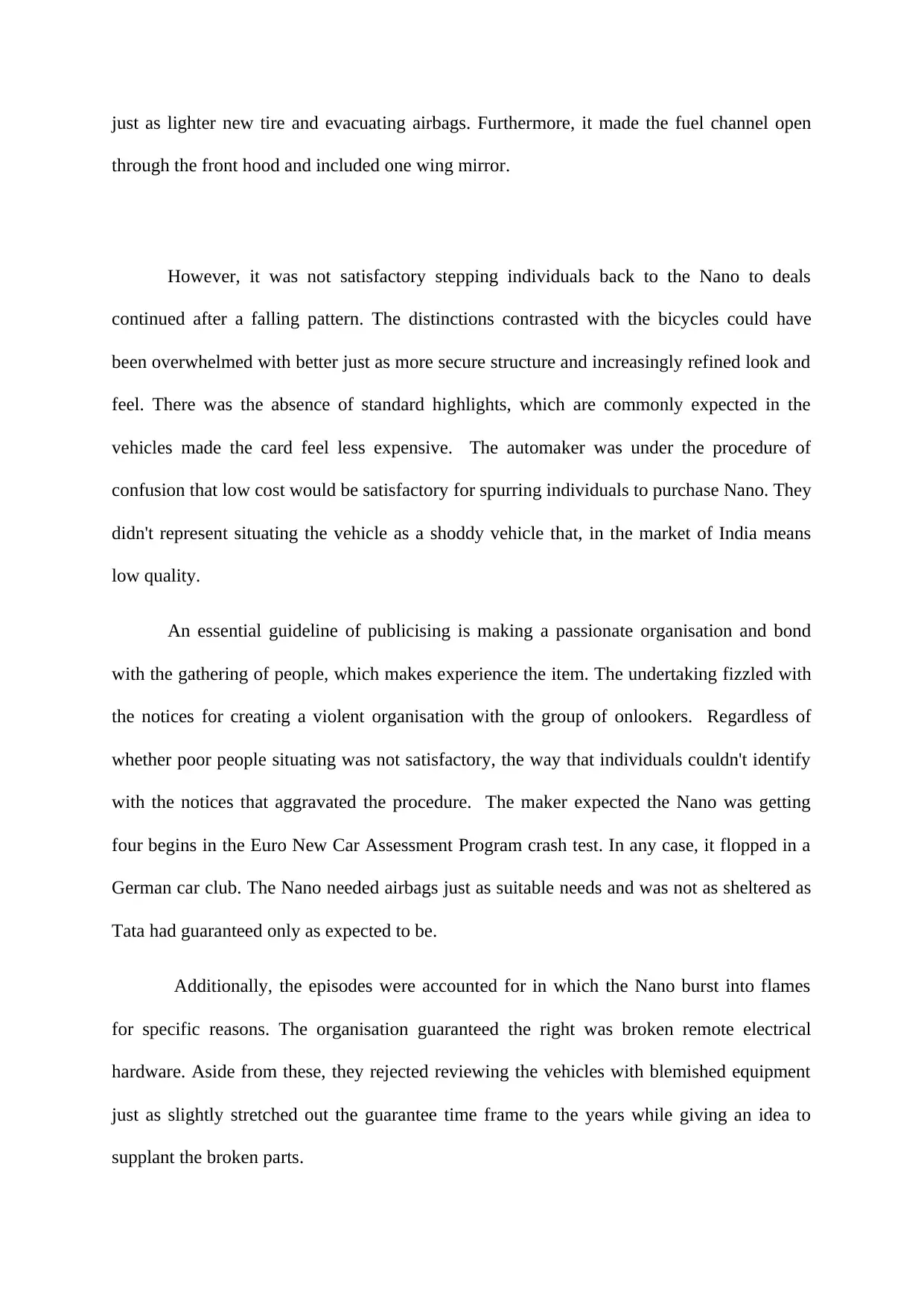
just as lighter new tire and evacuating airbags. Furthermore, it made the fuel channel open
through the front hood and included one wing mirror.
However, it was not satisfactory stepping individuals back to the Nano to deals
continued after a falling pattern. The distinctions contrasted with the bicycles could have
been overwhelmed with better just as more secure structure and increasingly refined look and
feel. There was the absence of standard highlights, which are commonly expected in the
vehicles made the card feel less expensive. The automaker was under the procedure of
confusion that low cost would be satisfactory for spurring individuals to purchase Nano. They
didn't represent situating the vehicle as a shoddy vehicle that, in the market of India means
low quality.
An essential guideline of publicising is making a passionate organisation and bond
with the gathering of people, which makes experience the item. The undertaking fizzled with
the notices for creating a violent organisation with the group of onlookers. Regardless of
whether poor people situating was not satisfactory, the way that individuals couldn't identify
with the notices that aggravated the procedure. The maker expected the Nano was getting
four begins in the Euro New Car Assessment Program crash test. In any case, it flopped in a
German car club. The Nano needed airbags just as suitable needs and was not as sheltered as
Tata had guaranteed only as expected to be.
Additionally, the episodes were accounted for in which the Nano burst into flames
for specific reasons. The organisation guaranteed the right was broken remote electrical
hardware. Aside from these, they rejected reviewing the vehicles with blemished equipment
just as slightly stretched out the guarantee time frame to the years while giving an idea to
supplant the broken parts.
through the front hood and included one wing mirror.
However, it was not satisfactory stepping individuals back to the Nano to deals
continued after a falling pattern. The distinctions contrasted with the bicycles could have
been overwhelmed with better just as more secure structure and increasingly refined look and
feel. There was the absence of standard highlights, which are commonly expected in the
vehicles made the card feel less expensive. The automaker was under the procedure of
confusion that low cost would be satisfactory for spurring individuals to purchase Nano. They
didn't represent situating the vehicle as a shoddy vehicle that, in the market of India means
low quality.
An essential guideline of publicising is making a passionate organisation and bond
with the gathering of people, which makes experience the item. The undertaking fizzled with
the notices for creating a violent organisation with the group of onlookers. Regardless of
whether poor people situating was not satisfactory, the way that individuals couldn't identify
with the notices that aggravated the procedure. The maker expected the Nano was getting
four begins in the Euro New Car Assessment Program crash test. In any case, it flopped in a
German car club. The Nano needed airbags just as suitable needs and was not as sheltered as
Tata had guaranteed only as expected to be.
Additionally, the episodes were accounted for in which the Nano burst into flames
for specific reasons. The organisation guaranteed the right was broken remote electrical
hardware. Aside from these, they rejected reviewing the vehicles with blemished equipment
just as slightly stretched out the guarantee time frame to the years while giving an idea to
supplant the broken parts.
⊘ This is a preview!⊘
Do you want full access?
Subscribe today to unlock all pages.

Trusted by 1+ million students worldwide
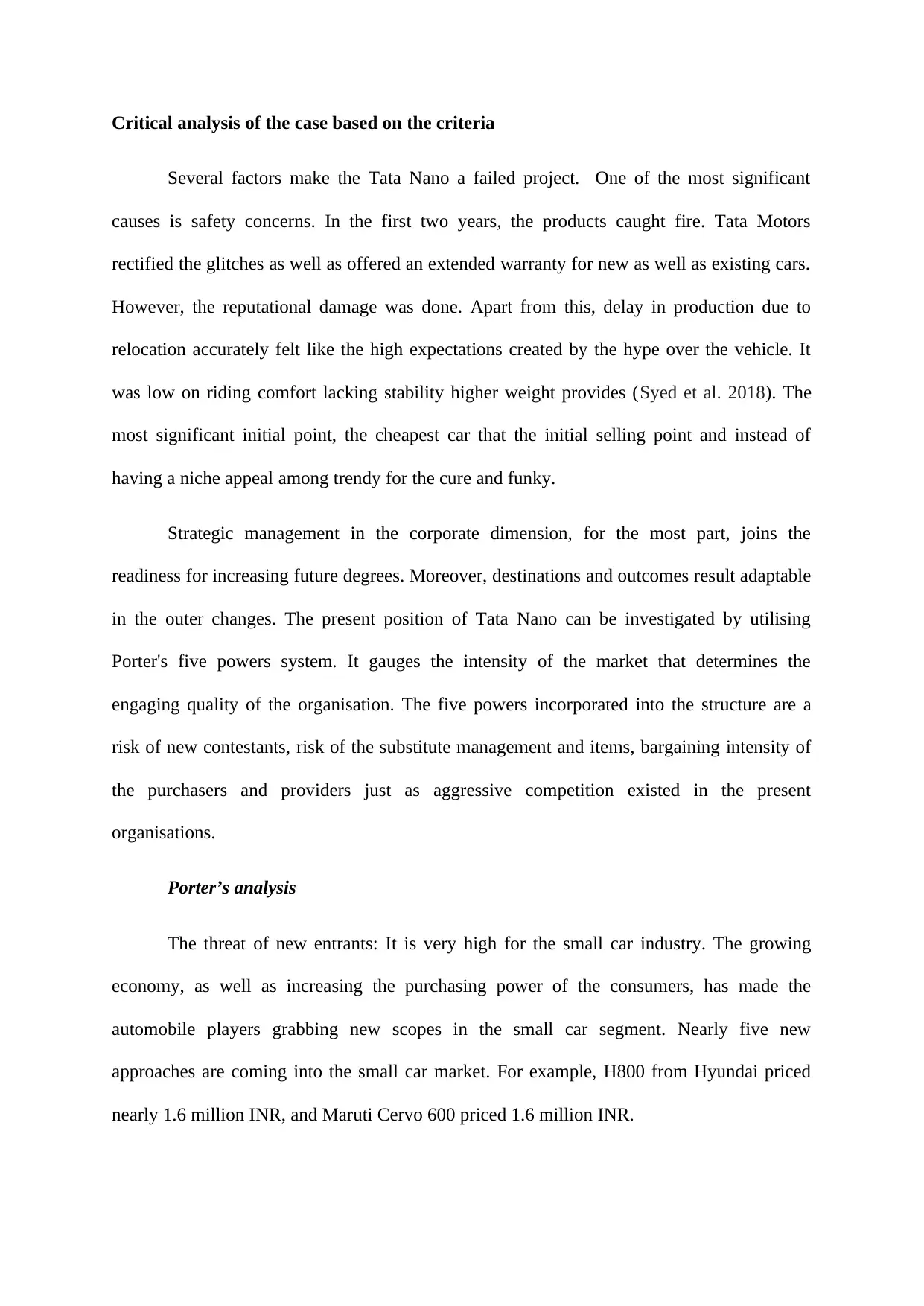
Critical analysis of the case based on the criteria
Several factors make the Tata Nano a failed project. One of the most significant
causes is safety concerns. In the first two years, the products caught fire. Tata Motors
rectified the glitches as well as offered an extended warranty for new as well as existing cars.
However, the reputational damage was done. Apart from this, delay in production due to
relocation accurately felt like the high expectations created by the hype over the vehicle. It
was low on riding comfort lacking stability higher weight provides (Syed et al. 2018). The
most significant initial point, the cheapest car that the initial selling point and instead of
having a niche appeal among trendy for the cure and funky.
Strategic management in the corporate dimension, for the most part, joins the
readiness for increasing future degrees. Moreover, destinations and outcomes result adaptable
in the outer changes. The present position of Tata Nano can be investigated by utilising
Porter's five powers system. It gauges the intensity of the market that determines the
engaging quality of the organisation. The five powers incorporated into the structure are a
risk of new contestants, risk of the substitute management and items, bargaining intensity of
the purchasers and providers just as aggressive competition existed in the present
organisations.
Porter’s analysis
The threat of new entrants: It is very high for the small car industry. The growing
economy, as well as increasing the purchasing power of the consumers, has made the
automobile players grabbing new scopes in the small car segment. Nearly five new
approaches are coming into the small car market. For example, H800 from Hyundai priced
nearly 1.6 million INR, and Maruti Cervo 600 priced 1.6 million INR.
Several factors make the Tata Nano a failed project. One of the most significant
causes is safety concerns. In the first two years, the products caught fire. Tata Motors
rectified the glitches as well as offered an extended warranty for new as well as existing cars.
However, the reputational damage was done. Apart from this, delay in production due to
relocation accurately felt like the high expectations created by the hype over the vehicle. It
was low on riding comfort lacking stability higher weight provides (Syed et al. 2018). The
most significant initial point, the cheapest car that the initial selling point and instead of
having a niche appeal among trendy for the cure and funky.
Strategic management in the corporate dimension, for the most part, joins the
readiness for increasing future degrees. Moreover, destinations and outcomes result adaptable
in the outer changes. The present position of Tata Nano can be investigated by utilising
Porter's five powers system. It gauges the intensity of the market that determines the
engaging quality of the organisation. The five powers incorporated into the structure are a
risk of new contestants, risk of the substitute management and items, bargaining intensity of
the purchasers and providers just as aggressive competition existed in the present
organisations.
Porter’s analysis
The threat of new entrants: It is very high for the small car industry. The growing
economy, as well as increasing the purchasing power of the consumers, has made the
automobile players grabbing new scopes in the small car segment. Nearly five new
approaches are coming into the small car market. For example, H800 from Hyundai priced
nearly 1.6 million INR, and Maruti Cervo 600 priced 1.6 million INR.
Paraphrase This Document
Need a fresh take? Get an instant paraphrase of this document with our AI Paraphraser
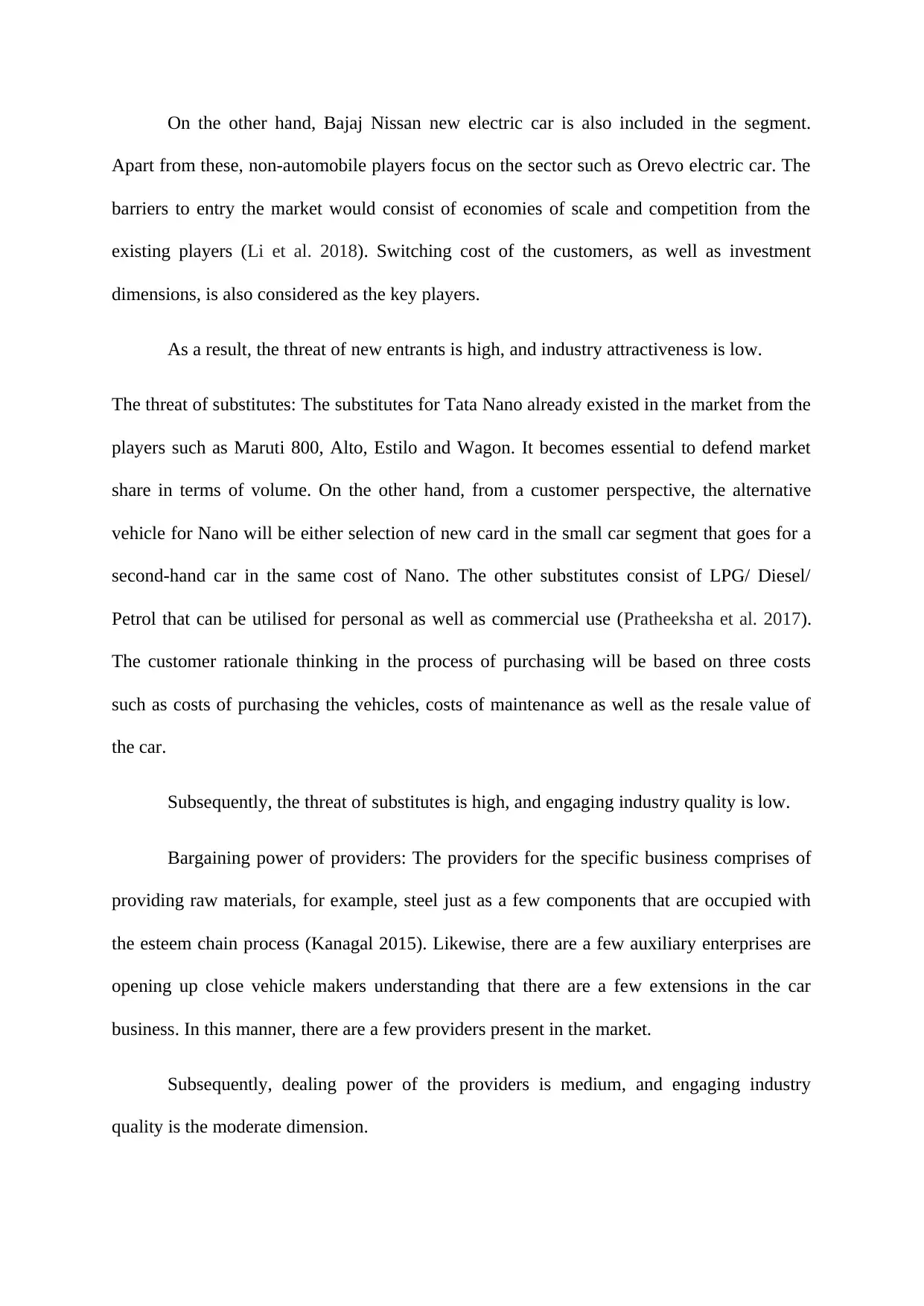
On the other hand, Bajaj Nissan new electric car is also included in the segment.
Apart from these, non-automobile players focus on the sector such as Orevo electric car. The
barriers to entry the market would consist of economies of scale and competition from the
existing players (Li et al. 2018). Switching cost of the customers, as well as investment
dimensions, is also considered as the key players.
As a result, the threat of new entrants is high, and industry attractiveness is low.
The threat of substitutes: The substitutes for Tata Nano already existed in the market from the
players such as Maruti 800, Alto, Estilo and Wagon. It becomes essential to defend market
share in terms of volume. On the other hand, from a customer perspective, the alternative
vehicle for Nano will be either selection of new card in the small car segment that goes for a
second-hand car in the same cost of Nano. The other substitutes consist of LPG/ Diesel/
Petrol that can be utilised for personal as well as commercial use (Pratheeksha et al. 2017).
The customer rationale thinking in the process of purchasing will be based on three costs
such as costs of purchasing the vehicles, costs of maintenance as well as the resale value of
the car.
Subsequently, the threat of substitutes is high, and engaging industry quality is low.
Bargaining power of providers: The providers for the specific business comprises of
providing raw materials, for example, steel just as a few components that are occupied with
the esteem chain process (Kanagal 2015). Likewise, there are a few auxiliary enterprises are
opening up close vehicle makers understanding that there are a few extensions in the car
business. In this manner, there are a few providers present in the market.
Subsequently, dealing power of the providers is medium, and engaging industry
quality is the moderate dimension.
Apart from these, non-automobile players focus on the sector such as Orevo electric car. The
barriers to entry the market would consist of economies of scale and competition from the
existing players (Li et al. 2018). Switching cost of the customers, as well as investment
dimensions, is also considered as the key players.
As a result, the threat of new entrants is high, and industry attractiveness is low.
The threat of substitutes: The substitutes for Tata Nano already existed in the market from the
players such as Maruti 800, Alto, Estilo and Wagon. It becomes essential to defend market
share in terms of volume. On the other hand, from a customer perspective, the alternative
vehicle for Nano will be either selection of new card in the small car segment that goes for a
second-hand car in the same cost of Nano. The other substitutes consist of LPG/ Diesel/
Petrol that can be utilised for personal as well as commercial use (Pratheeksha et al. 2017).
The customer rationale thinking in the process of purchasing will be based on three costs
such as costs of purchasing the vehicles, costs of maintenance as well as the resale value of
the car.
Subsequently, the threat of substitutes is high, and engaging industry quality is low.
Bargaining power of providers: The providers for the specific business comprises of
providing raw materials, for example, steel just as a few components that are occupied with
the esteem chain process (Kanagal 2015). Likewise, there are a few auxiliary enterprises are
opening up close vehicle makers understanding that there are a few extensions in the car
business. In this manner, there are a few providers present in the market.
Subsequently, dealing power of the providers is medium, and engaging industry
quality is the moderate dimension.
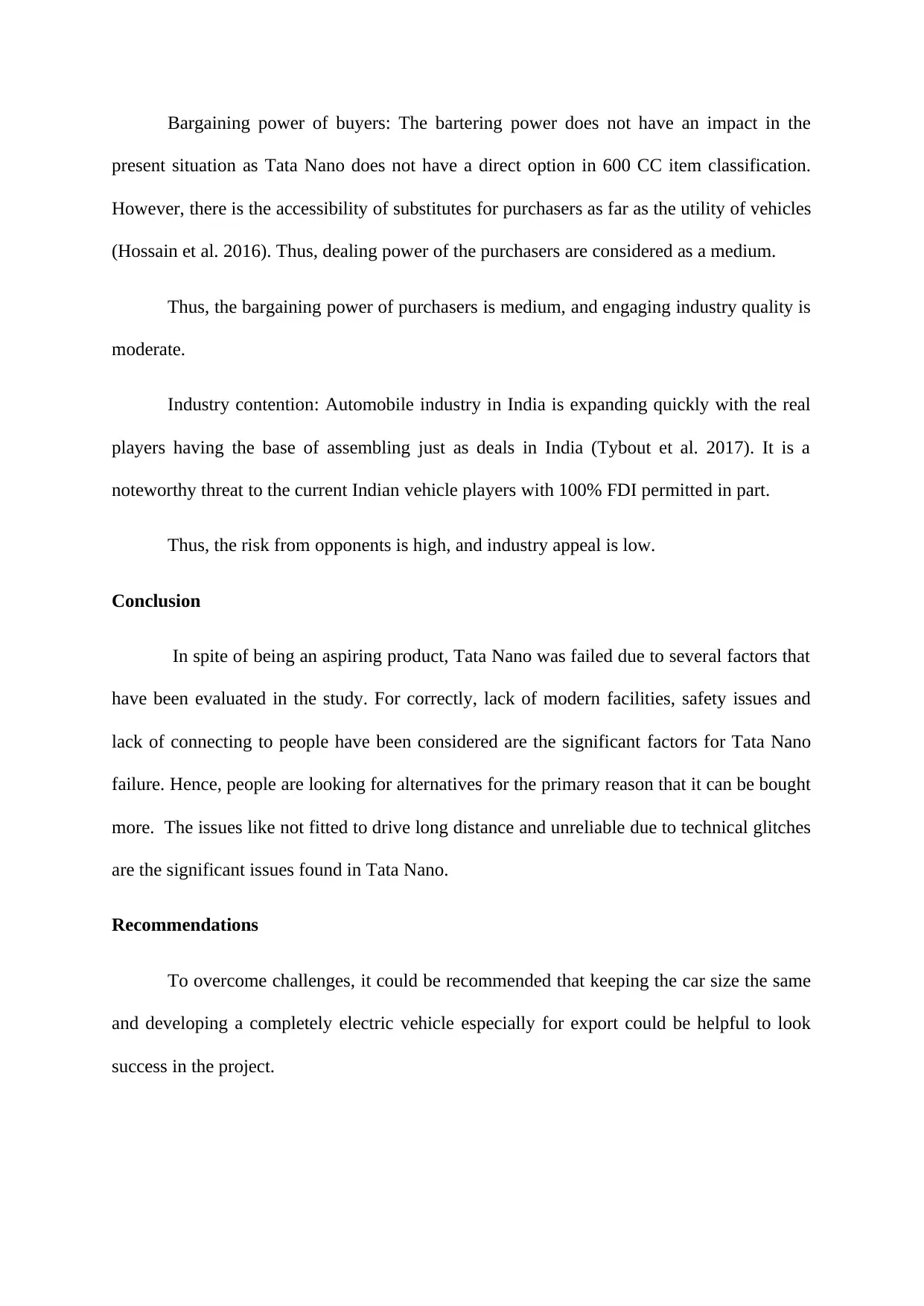
Bargaining power of buyers: The bartering power does not have an impact in the
present situation as Tata Nano does not have a direct option in 600 CC item classification.
However, there is the accessibility of substitutes for purchasers as far as the utility of vehicles
(Hossain et al. 2016). Thus, dealing power of the purchasers are considered as a medium.
Thus, the bargaining power of purchasers is medium, and engaging industry quality is
moderate.
Industry contention: Automobile industry in India is expanding quickly with the real
players having the base of assembling just as deals in India (Tybout et al. 2017). It is a
noteworthy threat to the current Indian vehicle players with 100% FDI permitted in part.
Thus, the risk from opponents is high, and industry appeal is low.
Conclusion
In spite of being an aspiring product, Tata Nano was failed due to several factors that
have been evaluated in the study. For correctly, lack of modern facilities, safety issues and
lack of connecting to people have been considered are the significant factors for Tata Nano
failure. Hence, people are looking for alternatives for the primary reason that it can be bought
more. The issues like not fitted to drive long distance and unreliable due to technical glitches
are the significant issues found in Tata Nano.
Recommendations
To overcome challenges, it could be recommended that keeping the car size the same
and developing a completely electric vehicle especially for export could be helpful to look
success in the project.
present situation as Tata Nano does not have a direct option in 600 CC item classification.
However, there is the accessibility of substitutes for purchasers as far as the utility of vehicles
(Hossain et al. 2016). Thus, dealing power of the purchasers are considered as a medium.
Thus, the bargaining power of purchasers is medium, and engaging industry quality is
moderate.
Industry contention: Automobile industry in India is expanding quickly with the real
players having the base of assembling just as deals in India (Tybout et al. 2017). It is a
noteworthy threat to the current Indian vehicle players with 100% FDI permitted in part.
Thus, the risk from opponents is high, and industry appeal is low.
Conclusion
In spite of being an aspiring product, Tata Nano was failed due to several factors that
have been evaluated in the study. For correctly, lack of modern facilities, safety issues and
lack of connecting to people have been considered are the significant factors for Tata Nano
failure. Hence, people are looking for alternatives for the primary reason that it can be bought
more. The issues like not fitted to drive long distance and unreliable due to technical glitches
are the significant issues found in Tata Nano.
Recommendations
To overcome challenges, it could be recommended that keeping the car size the same
and developing a completely electric vehicle especially for export could be helpful to look
success in the project.
⊘ This is a preview!⊘
Do you want full access?
Subscribe today to unlock all pages.

Trusted by 1+ million students worldwide
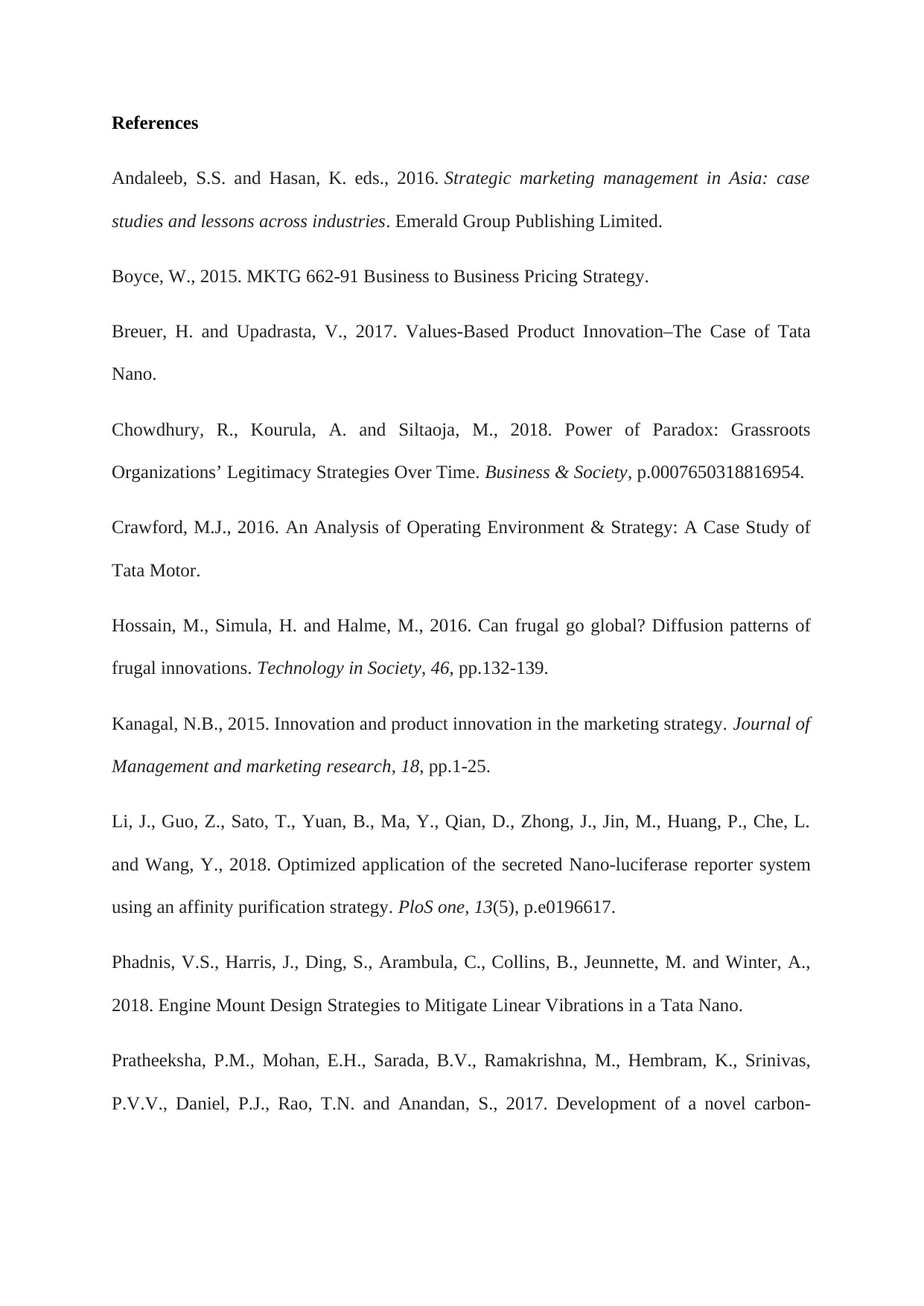
References
Andaleeb, S.S. and Hasan, K. eds., 2016. Strategic marketing management in Asia: case
studies and lessons across industries. Emerald Group Publishing Limited.
Boyce, W., 2015. MKTG 662-91 Business to Business Pricing Strategy.
Breuer, H. and Upadrasta, V., 2017. Values-Based Product Innovation–The Case of Tata
Nano.
Chowdhury, R., Kourula, A. and Siltaoja, M., 2018. Power of Paradox: Grassroots
Organizations’ Legitimacy Strategies Over Time. Business & Society, p.0007650318816954.
Crawford, M.J., 2016. An Analysis of Operating Environment & Strategy: A Case Study of
Tata Motor.
Hossain, M., Simula, H. and Halme, M., 2016. Can frugal go global? Diffusion patterns of
frugal innovations. Technology in Society, 46, pp.132-139.
Kanagal, N.B., 2015. Innovation and product innovation in the marketing strategy. Journal of
Management and marketing research, 18, pp.1-25.
Li, J., Guo, Z., Sato, T., Yuan, B., Ma, Y., Qian, D., Zhong, J., Jin, M., Huang, P., Che, L.
and Wang, Y., 2018. Optimized application of the secreted Nano-luciferase reporter system
using an affinity purification strategy. PloS one, 13(5), p.e0196617.
Phadnis, V.S., Harris, J., Ding, S., Arambula, C., Collins, B., Jeunnette, M. and Winter, A.,
2018. Engine Mount Design Strategies to Mitigate Linear Vibrations in a Tata Nano.
Pratheeksha, P.M., Mohan, E.H., Sarada, B.V., Ramakrishna, M., Hembram, K., Srinivas,
P.V.V., Daniel, P.J., Rao, T.N. and Anandan, S., 2017. Development of a novel carbon-
Andaleeb, S.S. and Hasan, K. eds., 2016. Strategic marketing management in Asia: case
studies and lessons across industries. Emerald Group Publishing Limited.
Boyce, W., 2015. MKTG 662-91 Business to Business Pricing Strategy.
Breuer, H. and Upadrasta, V., 2017. Values-Based Product Innovation–The Case of Tata
Nano.
Chowdhury, R., Kourula, A. and Siltaoja, M., 2018. Power of Paradox: Grassroots
Organizations’ Legitimacy Strategies Over Time. Business & Society, p.0007650318816954.
Crawford, M.J., 2016. An Analysis of Operating Environment & Strategy: A Case Study of
Tata Motor.
Hossain, M., Simula, H. and Halme, M., 2016. Can frugal go global? Diffusion patterns of
frugal innovations. Technology in Society, 46, pp.132-139.
Kanagal, N.B., 2015. Innovation and product innovation in the marketing strategy. Journal of
Management and marketing research, 18, pp.1-25.
Li, J., Guo, Z., Sato, T., Yuan, B., Ma, Y., Qian, D., Zhong, J., Jin, M., Huang, P., Che, L.
and Wang, Y., 2018. Optimized application of the secreted Nano-luciferase reporter system
using an affinity purification strategy. PloS one, 13(5), p.e0196617.
Phadnis, V.S., Harris, J., Ding, S., Arambula, C., Collins, B., Jeunnette, M. and Winter, A.,
2018. Engine Mount Design Strategies to Mitigate Linear Vibrations in a Tata Nano.
Pratheeksha, P.M., Mohan, E.H., Sarada, B.V., Ramakrishna, M., Hembram, K., Srinivas,
P.V.V., Daniel, P.J., Rao, T.N. and Anandan, S., 2017. Development of a novel carbon-
Paraphrase This Document
Need a fresh take? Get an instant paraphrase of this document with our AI Paraphraser
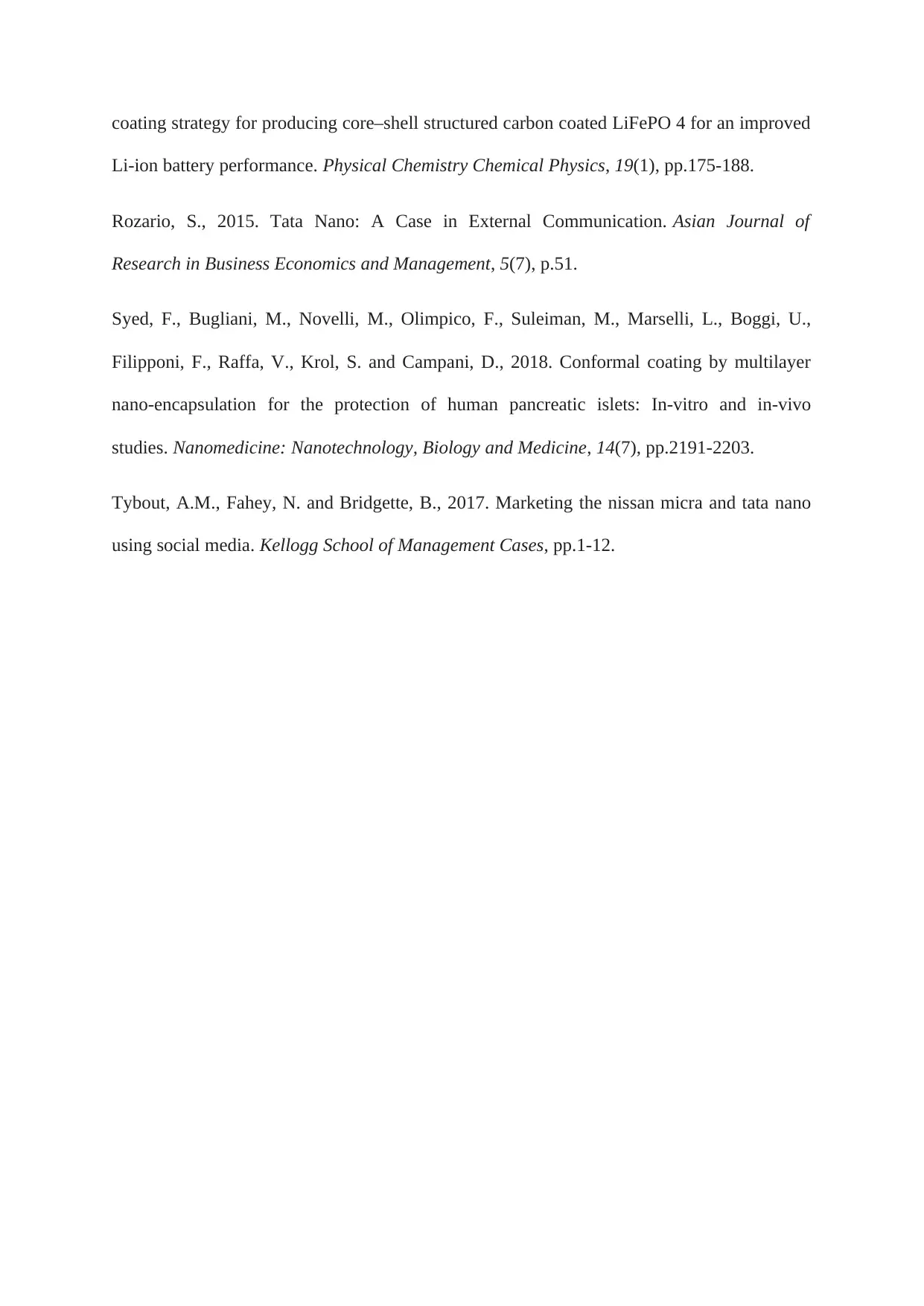
coating strategy for producing core–shell structured carbon coated LiFePO 4 for an improved
Li-ion battery performance. Physical Chemistry Chemical Physics, 19(1), pp.175-188.
Rozario, S., 2015. Tata Nano: A Case in External Communication. Asian Journal of
Research in Business Economics and Management, 5(7), p.51.
Syed, F., Bugliani, M., Novelli, M., Olimpico, F., Suleiman, M., Marselli, L., Boggi, U.,
Filipponi, F., Raffa, V., Krol, S. and Campani, D., 2018. Conformal coating by multilayer
nano-encapsulation for the protection of human pancreatic islets: In-vitro and in-vivo
studies. Nanomedicine: Nanotechnology, Biology and Medicine, 14(7), pp.2191-2203.
Tybout, A.M., Fahey, N. and Bridgette, B., 2017. Marketing the nissan micra and tata nano
using social media. Kellogg School of Management Cases, pp.1-12.
Li-ion battery performance. Physical Chemistry Chemical Physics, 19(1), pp.175-188.
Rozario, S., 2015. Tata Nano: A Case in External Communication. Asian Journal of
Research in Business Economics and Management, 5(7), p.51.
Syed, F., Bugliani, M., Novelli, M., Olimpico, F., Suleiman, M., Marselli, L., Boggi, U.,
Filipponi, F., Raffa, V., Krol, S. and Campani, D., 2018. Conformal coating by multilayer
nano-encapsulation for the protection of human pancreatic islets: In-vitro and in-vivo
studies. Nanomedicine: Nanotechnology, Biology and Medicine, 14(7), pp.2191-2203.
Tybout, A.M., Fahey, N. and Bridgette, B., 2017. Marketing the nissan micra and tata nano
using social media. Kellogg School of Management Cases, pp.1-12.
1 out of 11
Related Documents
Your All-in-One AI-Powered Toolkit for Academic Success.
+13062052269
info@desklib.com
Available 24*7 on WhatsApp / Email
![[object Object]](/_next/static/media/star-bottom.7253800d.svg)
Unlock your academic potential
Copyright © 2020–2025 A2Z Services. All Rights Reserved. Developed and managed by ZUCOL.





